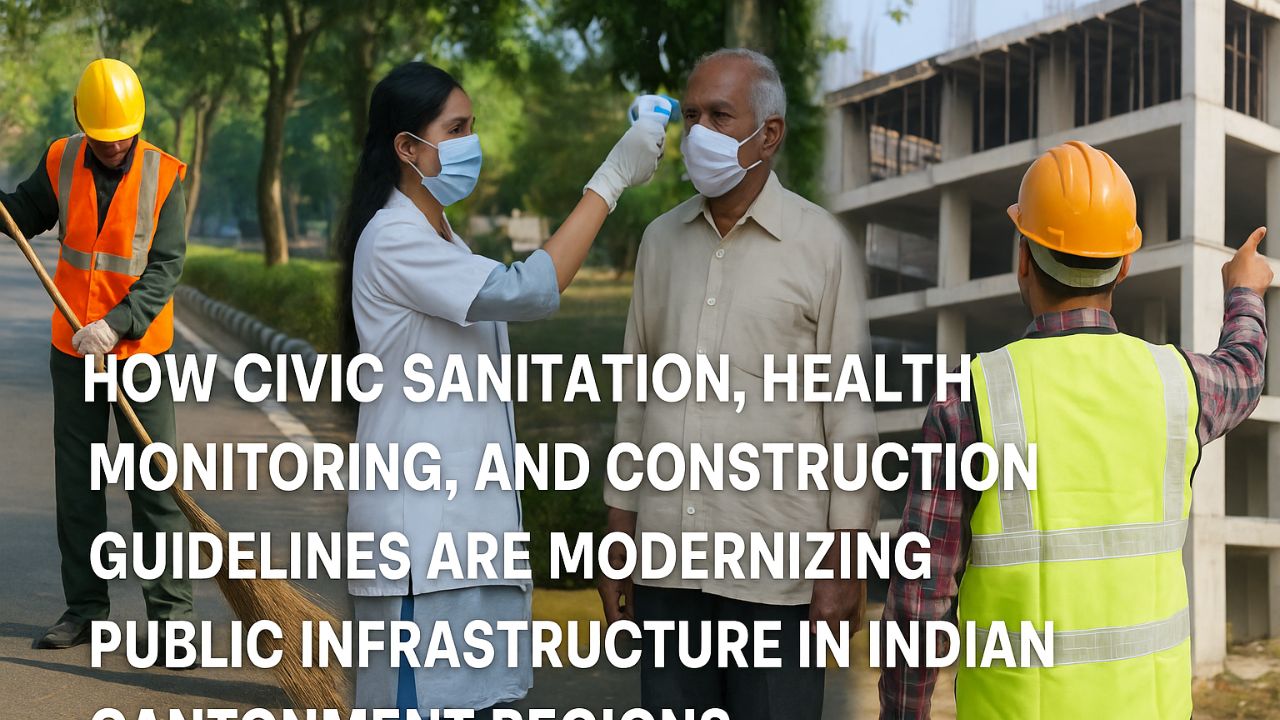Indian Cantonment Regions – Indian cantonment regions, historically known for their military importance, are now undergoing a transformative phase in terms of public infrastructure and civic administration. With rising civilian populations and increasing demands for modern amenities, the Cantonment Boards across India are embracing modernization through upgraded sanitation systems, health surveillance mechanisms, and strict construction guidelines. These measures not only aim to improve the quality of life but also to bring transparency, sustainability, and smart governance to cantonment areas. Let’s explore how these three pillars—civic sanitation, health monitoring, and construction norms—are creating cleaner, healthier, and better-regulated urban zones in cantonments.
Civic Sanitation Reforms: Building a Cleaner Living Environment
Cantonment Boards have made significant strides in revamping their sanitation systems, incorporating modern technologies and citizen participation.
- Introduction of smart bins with sensors to track waste levels
- Daily mechanized sweeping in major streets and markets
- Segregation of dry and wet waste at source made mandatory
- Weekly door-to-door garbage collection via GPS-tracked vehicles
- Composting units and small-scale waste-to-energy plants installed
- Public toilets renovated under Swachh Bharat Mission guidelines
- Monthly cleanliness audits conducted by Health Inspectors
- Resident Welfare Associations involved in cleanliness drives

Modern India Upgrade
Key Sanitation Upgrades in Major Cantonments
| Cantonment Name | Smart Bins Installed | Door Collection Coverage | Waste Treatment Facility | Cleanliness Rank 2024 |
|---|---|---|---|---|
| Pune Cantonment | 125 | 98% | Composting Unit | 4 |
| Ambala Cantonment | 90 | 100% | Bio-Methanation Plant | 7 |
| Secunderabad Cantt. | 140 | 95% | Incinerator & RDF Plant | 3 |
| Lucknow Cantonment | 75 | 93% | Composting Pit | 10 |
| Chennai Cantonment | 110 | 97% | Dual Segregation Units | 5 |
Health Monitoring: Digital Surveillance and Community Health Safety
In the wake of the COVID-19 pandemic, health monitoring has become a priority for cantonment boards.
These are the new initiatives being implemented:
- Establishment of digital health kiosks for basic diagnostics
- Annual health surveys of cantonment residents
- Electronic Health Records (EHR) of registered families
- Monitoring of school children’s nutrition and health levels
- Mobile medical units dispatched in remote zones
- Monthly reporting of communicable diseases to HQ
- AI-enabled disease outbreak alert systems
- Immunization tracking for newborns and senior citizens
Health Infrastructure & Services in Cantonment Areas
| Health Facility | Availability | Digital Records | Telemedicine Support | Emergency Response Time |
|---|---|---|---|---|
| Cantonment Dispensary | 100% | Yes | Yes | Within 30 mins |
| Mobile Clinics | 80% | Yes | No | Within 1 hour |
| Community Health App | 60% | Yes | Yes | 24×7 via app |
| Telemedicine Booths | 40% | Partial | Yes | Limited to 5 km radius |
Construction Guidelines: Regulating Development Without Compromising Defense
To ensure planned development and avoid security risks, cantonment boards have rolled out strict yet transparent construction norms.
Key features of the revised construction guidelines:
- Mandatory approval from Cantonment Board before any structural change
- Online application and approval system for building plans
- Height restrictions around military zones enforced strictly
- All commercial activities restricted to pre-designated zones
- Building completion certificates digitized for easy verification
- Environmental clearance required for large constructions
- Encroachments identified via satellite mapping and removed
- Green building norms encouraged with subsidy on solar rooftops

Cantonment Reforms Revealed
Tech-Driven Monitoring of Construction and Urban Development
To maintain transparency, many cantonments have adopted drone and GIS technology.
- Real-time tracking of illegal construction via drone surveys
- GIS-based mapping of residential and commercial zones
- QR-code linked property tax payments and building data
- AI-powered approval workflows reduce paperwork delays
Role of Cantonment Boards and Residents in Civic Governance
Public participation is now at the core of governance in cantonment areas. Residents, through feedback portals and ward committees, can directly influence decision-making.
Key civic engagement mechanisms include:
- Monthly “Jan Sunwai” grievance hearings by board officials
- Resident dashboard for complaints, water, electricity, and waste
- Annual public audits on sanitation, construction, and health
- Women Self Help Groups (SHGs) engaged in community health
Challenges Faced in Implementation and How They’re Being Solved
Despite progress, cantonment regions face specific hurdles due to their hybrid nature—military + civilian population.
Some ongoing challenges:
- Jurisdictional confusion between Board and Army units
- Water supply issues due to shared resources with Army
- Slower fund release from central government schemes
- Encroachment by local vendors in market zones
Solutions Implemented:
- Creation of Joint Coordination Committees (Army + Board)
- Adoption of PPP model for water and electricity supply
- Cantonment Development Cells formed at Ministry level
- Digital encroachment complaint platform for faster resolution
FAQs
Q1. Are civilians living in cantonments eligible for all these infrastructure benefits?
Yes, registered civilians within cantonment areas receive all civic benefits including health, sanitation, and regulated construction permissions.
Q2. What is the role of the Ministry of Defence in cantonment modernization?
The Ministry of Defence supervises policy reforms and budget allocation for all 62 cantonments across India, in coordination with the Directorate General Defence Estates (DGDE).
Q3. How can a resident apply for construction approval in a cantonment area?
Applications can be submitted online through the e-Chhawani portal, along with property documents, drawings, and environmental clearance if needed.
Q4. Are sanitation systems the same across all cantonments?
While basic guidelines are uniform, execution may vary by region based on population density, terrain, and available budget.
Q5. Is healthcare in cantonments free for all residents?
Basic healthcare is subsidized or free for registered residents, especially through government-run dispensaries and mobile clinics.






